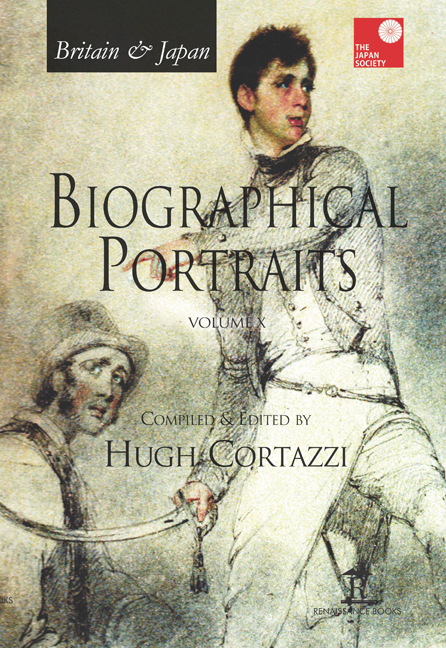Book contents
- Frontmatter
- Dedication
- Contents
- Introduction
- List of Contributors
- Index of Biographical Portraits in Japan Society Volumes
- PART I BRITAIN IN JAPAN
- PART II JAPAN IN BRITAIN
- Select Bibliography of Works in English on Anglo-Japanese Relations [Compiled by Gill Goddard – Retired East Asian Studies Librarian, University of Sheffield]
- Select Bibliography of Works in Japanese on Anglo-Japanese Relations [Compiled by Akira Hirano, SISJAC]
- Index
64 - Mackintosh and the Glasgow Style: Japonisme
Published online by Cambridge University Press: 07 May 2022
- Frontmatter
- Dedication
- Contents
- Introduction
- List of Contributors
- Index of Biographical Portraits in Japan Society Volumes
- PART I BRITAIN IN JAPAN
- PART II JAPAN IN BRITAIN
- Select Bibliography of Works in English on Anglo-Japanese Relations [Compiled by Gill Goddard – Retired East Asian Studies Librarian, University of Sheffield]
- Select Bibliography of Works in Japanese on Anglo-Japanese Relations [Compiled by Akira Hirano, SISJAC]
- Index
Summary
INTRODUCTION
THEY WERE KNOWN as ‘The Four’, the ‘Mac’ group. Voysey, whose work they admired, named them the ‘Spook School’. The critics, who were mainly English, mistrusted them and derided their work as being hopelessly Art Nouveau. Writers referred to the style as ‘hooliganism’ and ‘a blasphemy against art’, it was Symbolist, Celtic Revival, it was almost Arts and Crafts, it was Art Deco, it was linked to the Vienna Secessionists, it was influenced by Japonisme and, by a huge stretch of the imagination, the Egyptian Court at the British Museum.
The group confidently referred to themselves as ‘The Immortals’. Who were they? The main protagonists, ‘The Four’, were Charles Rennie Mackintosh and Herbert MacNair and the sisters Margaret and Frances Macdonald (who married the two men). Katherine Cameron, Janet Aitken, Agnes Raeburn, John Keppie and his sister Jessie (at one stage engaged to Mackintosh), Talwin Morris, George Walton, Ernest Archibald Taylor, John Ednie, George Logan and Jessie King were associated with the Glasgow Style and their mentors were Francis ‘Fra’ Newbery and his wife Jessie. Their motto was a quote from J.D. Sedding: ‘there is hope in honest error: none in the icy perfection of the mere stylist’.
A QUESTION OF STYLE
In the latter part of the nineteenth century and the early twentieth century there was a proliferation of art and design magazines across Europe, for example The Studio in Britain, Jugend and Dekorative Kunst in Germany and Ver Sacrum in Austria which resulted in a cross-fertilisation of ideas and a blurring of specific identifications. There are elements of the Glasgow Style, which can be regarded as Art Nouveau, and Mackintosh, MacNair and Margaret Macdonald all exhibited at Siegfried Bing's Galeries l’Art Nouveau, but in general their designs are more tightly contained than the exaggerated ‘squirms’ of their European counterparts. Alfred Gilbert termed Art Nouveau an ‘absolute nonsense … [a] mud mountain of rubbish daily and yearly heaped up by the incompetent, social, amateur ass’, a description one would hesitate to apply to the Glasgow Style. Celtic ornamentation involves similar whiplash and rounded shapes as Art Nouveau and the fact that the group were initially based in Glasgow (although many were in fact English) probably led to this attribution although Glaswegians associated Celtic design with the Catholic Irish immigrants and preferred to play down the influence.
- Type
- Chapter
- Information
- Britain & Japan Biographical Portraits Vol X , pp. 731 - 744Publisher: Amsterdam University PressPrint publication year: 2016

